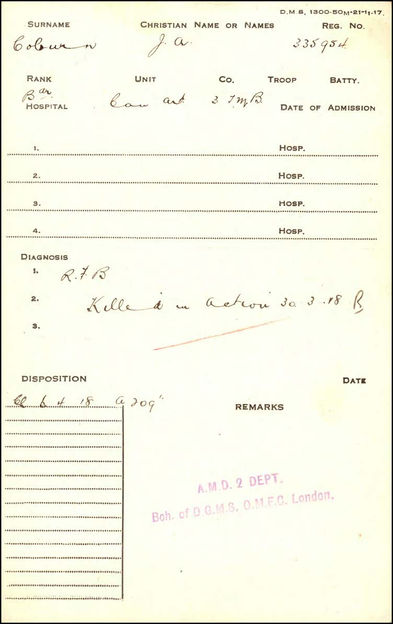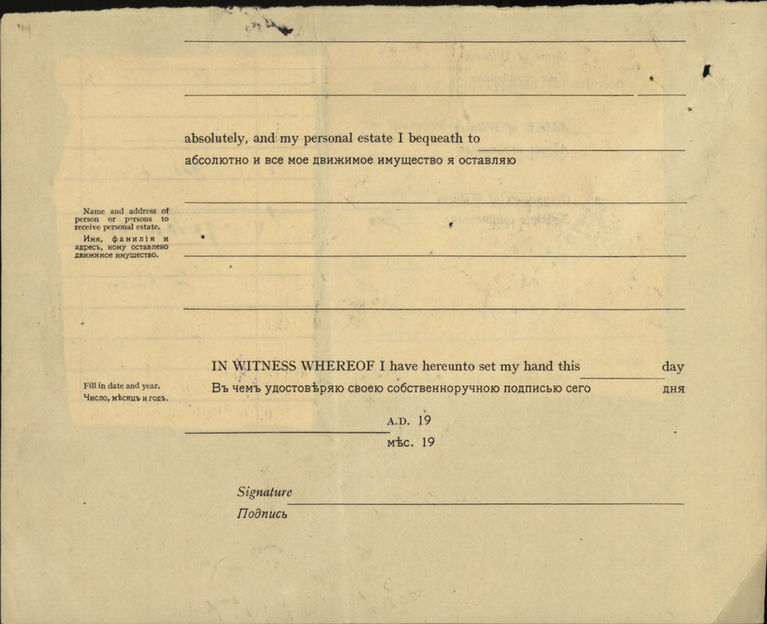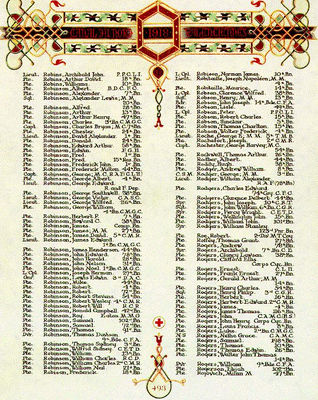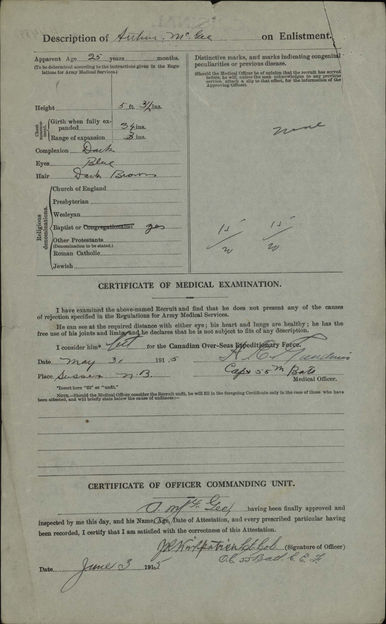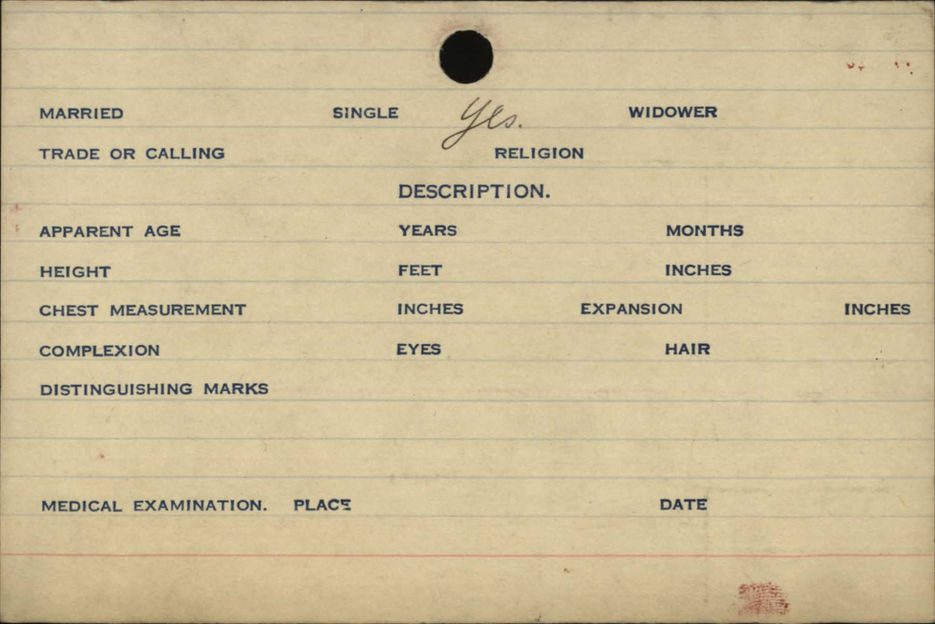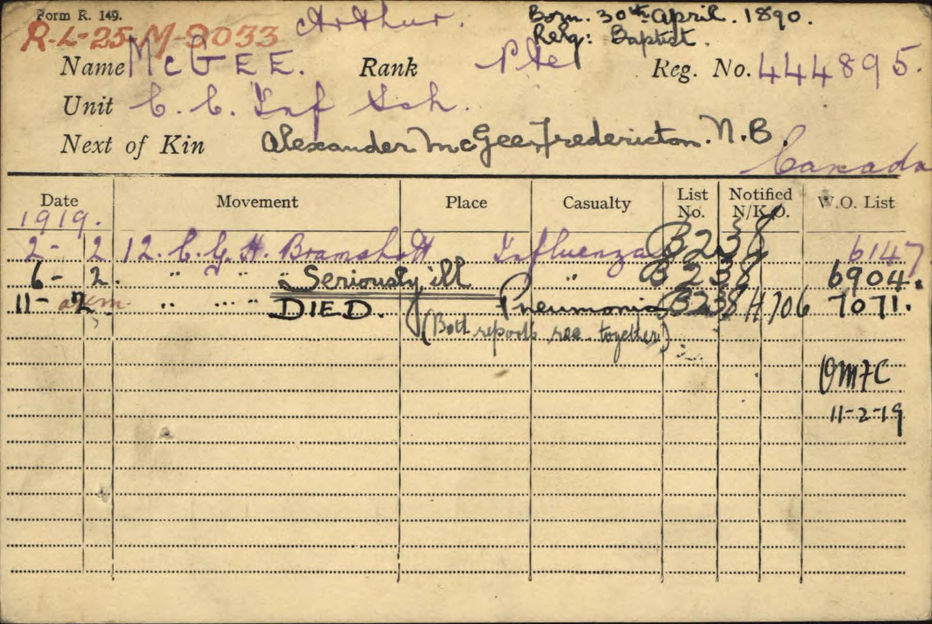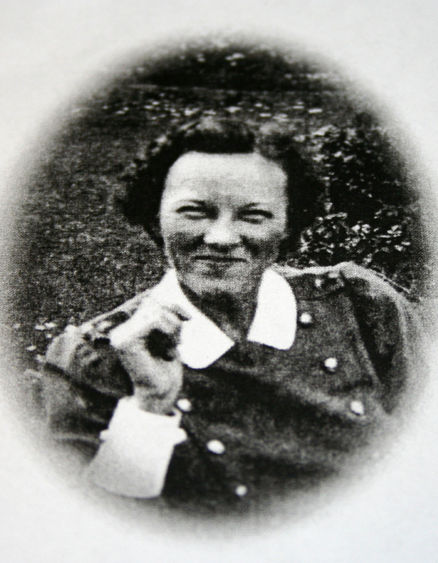In memory of
Bombardier
JAMES "ALEXANDER" MacLean Coburn
August 22, 1886 - March 30, 1918
Military Service:
Service Number: 335954
Age: 31
Force: Army
Unit: Canadian Field Artillery, Canadian Expeditionary Force (CEF)
Division: 3rd Div. Trench Mortar Bty.
Commemorated on Page 386 of the First World War Book of Remembrance.
Military Service Records:
When a recruit signed up for the Canadian Expeditionary Force in WW I he filled in an attestation paper that indicated his willingness to serve in the military and provided such information as date of birth, next of kin, height, weight, complexion, occupation, etc. As such these papers are of genealogical importance. The links below are to a scanned copy of the attestation papers of James Alexander MacLean Coburn completed on 3 July 1916, in Woodstock New Brunswick.
Date of Enlistment:
July 3, 1916, Woodstock, New Brunswick, Canada
Additional Information:
James "Alexander" MacLean Coburn, born 22 Aug 1886, son of John G. Coburn and Margaret Ann Nesbitt, Harvey, NB, died 30 Mar 1918, France, Battle of the Somme.
Cemetery:
La Targette British Cemetery, Pas de Calais,France.
La Targette British Cemetery is in the Western angle of the cross roads at Aux-Rietz. This Cemetery was formerly known as the Aux-Rietz Military Cemetery, and was begun at the end of April, 1917, and used by Field Ambulances and fighting units until September, 1918. Sixteen graves were brought in from the immediate neighbourhood after the Armistice.
In March-April 1917, the artillery of the 2nd Canadian and 5th Divisions, and certain heavy artillery units, had their headquarters in a deep cave at Aux-Rietz. Nearly a third of the graves, including Bdr. Alexander Coburn, have an artillery connection.
The 21st Canadian Infantry Battalion erected a wooden memorial in the cemetery to their dead of April, 1917. The cemetery covers an area of 2,852 square metres and is enclosed by a stone curb on two sides, and on the other two by a low rubble wall.
The cemetery was designed by Sir Reginald Blomfield.
The cemetery contains 638 First World War burials, 41 of them unidentified. There are also three Second World War burials, two of which are unidentified.
Location:
Neuville-St Vaast is a village 6.5 kilometres north of Arras, a little east of the road from Bethune to Arras. La Targette British Cemetery lies to the south-west of the village on the north-west side of the road to the village of Maroeuil.
Grave Reference:
I. J. 5.


The First Battle of Somme (1918) 21 Mar - 5 Apr 1918
The First Somme battle of 1918 is also known as the Battle of Saint-Quentin or the Second Battle of the Somme. It lasted from March 21–April 5 1918. The 1918 Spring Offensive or Kaiserschlacht was a series of German attacks along the Western Front during the First World War, which marked the deepest advances by either side since 1914. The German Artillery rained down shells on the British and Allied positions, purposely targeting the British artillery and rear lines of troops, ready for what they hoped would be a lighting attack to split the British and French Lines, hoping to push the British forces back to the channel. Casualties on both sides were horrendous.
The first attack of the German Spring Offensive (codenamed Michael) was launched from the Hindenburg Line, on March 21, in the vicinity of Saint-Quentin. It reached a crisis at Villers-Bretonneux a little to the east of the key Allied communications centre of Amiens. The winning of that battle by the Allies, marked the beginning of the end of the First World War, as this Western front was much the most significant by this stage and the German advance stalled largely through an inability to maintain supplies.
As an important part of the German tactics in this battle was to target artillery it is possible that Bdr. Coburn was killed in action on March 30 as part of routine German counter battery fire, although his death could have been accidental (e.g. faulty ammunition or artillery piece misfire).
Source:
Wikipedia, Veterans Affairs Canada
In memory of
Private
ARCHIBALD "ARCHIE" LITTLE
May 15, 1884 - May 19, 1918
Military Service:
Service Number: 3256948
Age: 34
Force: Army
Unit: Canadian Infantry (New Brunswick Regiment), Canadian Expeditionary Force (CEF)
Division: 1st Depot Battallion
Commemorated on Page 450 of the First World War Book of Remembrance.
Military Service Records:
When a recruit signed up for the Canadian Expeditionary Force in WW I he filled in an attestation paper that indicated his willingness to serve in the military and provided such information as date of birth, next of kin, height, weight, complexion, occupation, etc. As such these papers are of genealogical importance. The links below are to a scanned copy of the attestion papers of Archie Little completed on 16 April 1918, in St. John, New Brunswick when he was drafted into the 1st Depot Battallion of the Canadian Expeditionary Force under the Military Service Act of 1917.
Date of Enlistment:
April 16, 1918, St. John, New Brunswick, Canada
Additional Information:
Private Archie Little was the son of Robert Archibald Little and Jane "Janie" Robison , of Harvey Station. Born 15 May 1884, Harvey, and died 19 May, 1918, WWI, Spinal meningitis while in training.
Cemetery:
Harvey Settlement Cemetery, Harvey Station, York County, New Brunswick,Canada
Grave Reference:
1Little Family Plot. Section A, Plot 384.
Stone reads:
Archie Little, died May 19, 1918 aged 34 years.
1. Swan Hall, J.,Craig, H.C., Wood, G., Wood, M. 1999. Harvey Settlement Cemetery 1837-1999, ISBN 0-9687457-0-9, 141 p.
Newspaper obituary
2From newspaper obituary - 1918:
Private Archie Little
The body of Private Archie Little who died at the hospital at Saint John on Sunday, was brought to his late residence at York Mills on Monday evening.
The funeral was held there yesterday and was largely attended. Interment was in the cemetery at Harvey.
The deceased, who was about thirty years of age, was the eldest son of Mr and Mrs Robert A. Little of York Mills. He had been in the military training camp at St. John only a few weeks when he was seized with a heavy cold which developed into spinal meningitis, which terminated fatally after about a week's illness. He was a young man of excellent character and his death is very deeply regretted.
2. Watson, J.S., Swan, B.S., Hall, J.S., 1992. The Little Family of Harvey Settlement, 380 p.
In memory of
Private
ARTHUR FREDERICK KINGSTON
October 1, 1889 - August 12, 1918
Military Service
Service Number: 1030674
Age: 28
Force: Army
Unit: Canadian Infantry (Quebec Regiment), Canadian Expeditionary Force (CEF)
Division: 42nd Battallion
Commemorated on Page 442 of the First World War Book of Remembrance.
Military Service Records:
When a recruit signed up for the Canadian Expeditionary Force in WW I he filled in an attestation paper that indicated his willingness to serve in the military and provided such information as date of birth, next of kin, height, weight, complexion, occupation, etc. As such these papers are of genealogical importance. The links below are to a scanned copy of the attestion papers of Arthur Kingston completed on 24 April 1917, in Fredericton, New Brunswick when he signed up with the 236th O.S. Battallion (New Brunswick Rifles - Sir Sam's Own).
Date of Enlistment:
April 24, 1917, Fredericton, New Brunswick, Canada
Additional Information:
Private Arthur Frederick Kingston was the son of Benedict "Bene" Kingston and Elizabeth Jane "Lizzie" Henry, York Mills, Harvey Station, York Co., NB. born 1 Oct 1889, Harvey, and died 12 Aug 1918, WWI, Battle of Amiens.
Cemetery:
Bouchoir New British Cemetery, Somme, France.
Bouchoir is a village in the Department of the Somme on the straight main road from Amiens to Roye. The Bouchoir New British Cemetery is on the north-east side of the road nearly 2 kilometres south-east of the village.
From Peronne take the N17 to Roye then the D934 to Amiens. Travel for approximately 8 kilometres and just before the village of Bouchoir the cemetery will be found on the right hand side of the road.
The village of Bouchoir was lost to the Allies on 27 March 1918 during the German armies massive sprng offensive but was recovered by the 8th Canadian Infantry Brigade on 9 August 1918. The New British Cemetery was created after the Armistice when graves were brought there from several small Commonwealth cemeteries and from the battlefields round Bouchoir and south of the village. Almost all date from March, April or August 1918. The graves in Plots I and II are numbered consecutively from 1 to 144. Those in Plot III are numbered from 1 to 135, and the same system applies to Plot IV. Plots V and VI are numbered by rows in the usual way.
Casualty Details: UK 542, Canada 214, Australia 6, South Africa 1, Total Burials: 763
Grave Reference:
V. D. 29
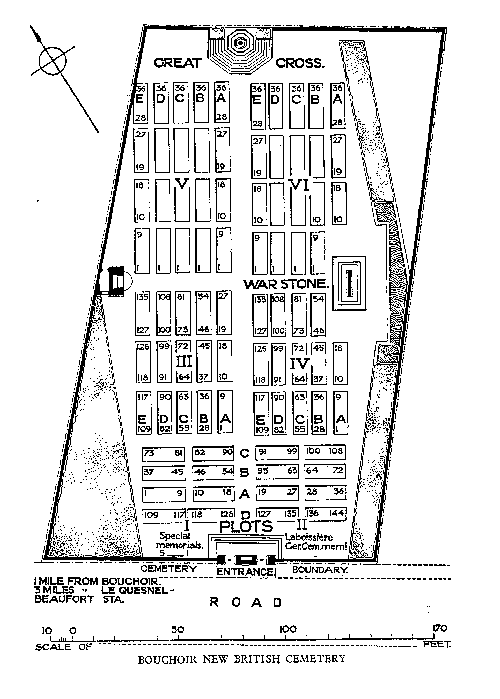

Battle of Amiens
Private Arthur Frederick Kingston was killed on Day 5 of the Battle of Amiens, which began on August 8th 1918. This battle marked the opening phase of the Allied offensive later known as the Hundred Days Offensive that ultimately led to the end of World War I. Allied forces, spear headed by the Canadian Corps advanced over seven miles on the first day, one of the greatest advances of the war although as the Canadians progressed beyond the reach of artillary support, and with the arrival of German reinforcements, their momentum slowed. The battle is also notable for its effects on German morale with a large number of German forces surrendering. This led Erich Ludendorff to famously describe the first day of the battle as "the black day of the German Army." Amiens was one of the first major battles involving a significant number of tanks and marked the end of trench warfare on the Western Front. Fighting became mobile once again and remained so until the armistice was signed on November 11th, 1918.
Newspaper obituary
From newspaper obituary - 1918:
Pte. A. F. Kingston
Pte. Arthur Frederick Kingston, whose death in action was reported August 12th, was the son of Mr and Mrs Benedict Kingston, of York Mills, NB, and was twenty eight years of age.
Pte. Kingston went overseas with 236th Kiltie Battalion in November 1917. He was afterwards transferred to another battalion and served three months in France.
Letters received by his mother from his lieutenant attest to his splendid courage and gallantry in face of the enemy, and how nobly he met his death, during the great drive which commenced August 8.
Besides his parents, he is survived by six sisters and two brothers, who have the sympathy of all in the loss of a worthy son and brother.
In memory of
Private
GRAY LITTLE
March 17, 1892 - August 28, 1918
Military Service
Service Number: 445112
Age: 26
Force: Army
Unit: Canadian Infantry (New Brunswick Regiment), Canadian Expeditionary Force (CEF)
Division: 26th Battallion
Commemorated on Page 450 of the First World War Book of Remembrance.
Military Service Records:
When a recruit signed up for the Canadian Expeditionary Force in WW I he filled in an attestation paper that indicated his willingness to serve in the military and provided such information as date of birth, next of kin, height, weight, complexion, occupation, etc. As such these papers are of genealogical importance. The links below are to a scanned copy of the attestion papers of Grey Little completed on 16 June 1915, in Sussex, New Brunswick when he signed up with the 55th Battallion, Canadian Expeditionary Force.
Date of Enlistment:
June 16, 1915, Sussex, New Brunswick, Canada
Additional Information:
Private Gray Little was the son of Alexander Little and Mary Ann Coburn, Harvey Station, York Co., NB. Born 17 Mar 1892, Harvey, and died 28 Aug 1918, WWI, Second Battle of Arras.
Cemetery:
Sun Quarry Cemetery, Pas de Calais, France.
Cherisy is a village approximately 13 kilometres south-east of Arras. The Cemetery is 1.5 kilometres south-east of the village on the north-east side of the D38 road to Hendecourt. Cherisy village was captured by the Allied 18th Division on May 3, 1917, but lost the same night; and it remained in German hands until it was retaken by the Canadian Corps on August 27, 1918. The cemetery takes it name from a flint quarry, known to the British Army as Sun Quarry, located a short distance south-east of Cherisy. The Cemetery covers an area of 462 square metres and is enclosed by brick walls.
Most of those buried in this cemetery were killed between 26 August and 28 September 1918 during the Battle of Arras.
Casualty Details: UK 30, Canada 161, Total Burials: 191
Grave Reference:
D. 11


The Second Battle of Arras (26 Aug - 3 Sept, 1918)
Private Gray Little was killed on Day 3 of the Battle of Arras, which began on August 26th, 1918. In this Battle the Canadian Corps, 100,000 strong attacked successive strong German lines and by September 2 had reached the Canal du Nord and in the process broke and turned the main German position on the Western Front.
After the Allied success in the Battle of Amiens, August 8-11, a renewal of the offensive on an extended front again brought the Canadian Corps into action, this time with the British First Army in the Arras sector. Sir Douglas Haig directed the First Army to strike eastward from Arras, and the hardened Canadian Corps once again became the spearhead of the attack. The Corps would assault astride the Arras-Cambrai road, with the canalized River Scarpe forming its left-hand boundary. The assignment given the Corps Commander, Lieutenant-General Sir Arthur Currie, was both important and difficult. A series of formidable defence positions barred the Canadian path, and in fortifying these the Germans had made full use of the deeply cut valleys and intervening ridges that crossed the battle area. Strongest of all, about nine miles east of Arras, was the Drocourt-Quéant (or D-Q) Line. Extending northward as a switch-line from the main Hindenburg position, this formidable deep system of trenches, fortified with concrete shelters and thick belts of wire, had been constructed by the Germans to contain any Allied advance into the Douai plain.
The Canadians struck before dawn on August 26, with the 2nd Division on the right, south of the Cambrai road; the 3rd Division between the road and the Scarpe and on the left, north of the river, the 51st Highland Division, temporarily under Currie's command. Aided by a powerful artillery and machine-gun barrage, the attack made good progress. Early in the day, the 3rd Division took Monchy in a skilfully executed encircling attack. On the right, the 2nd Division captured the villages of Guémappe and Wancourt during the afternoon. By nightfall the Canadian Corps was holding a line 914 metres east of Monchy, having repulsed several counter-attacks launched by the enemy in a determined attempt to regain the battered town.
Orders issued by General Currie for the 27th were to break through the strong Fresnes-Rouvroy Line - an advance of eight kilometres. It took two more days of hard fighting before the strong defence system was pierced near Boiry-Notre-Dame; and when the Battle of the Scarpe ended on August 30, resolute enemy garrisons were still clinging stubbornly to sections of the Fresnes-Rouvroy Line.
In the first three days of the battle the 2nd and 3rd Canadian Divisions had advanced more than eight kilometres over difficult, broken country beset with a maze of stoutly held trenches, and had captured 3,300 prisoners and a large number of guns.
After a brief respite Currie launched the assault of the Drocourt-Quéant Line on September 2. As day was breaking, armour and infantry began advancing be-hind a strong barrage to storm the enemy's main defensive line in the west. South of the Cambrai road battalions of the 1st Division swept forward as their tanks knocked out enemy posts and flattened wire that had survived the preliminary gunfire. By 7:30 a.m. one battalion had overrun the main trenches and was into the German support line, as a fresh battalion passed through to seize the village of Cagnicourt. Suffering crippling casualties, the Canadians gained their objective in the Buissy Switch before mid-night.
Dury Memorial
In the centre the 4th Canadian Division, which had taken over much of the 4th British Division's front, had been fighting its own hard battle. Between Dury and the main road the front trenches of the D-Q line were sited along the forward slope of the long low hill of Mont Dury. The attacking infantry had, therefore, to advance up an open incline swept by the enemy's machine-guns. At the crest they came under deadly fire from more machine-guns, as well as from shelling by the German field batteries in the rear. In spite of mounting casualties the Canadian battalions, aided greatly by tanks, reached the crest by mid-morning and drove the enemy from a sunken road linking Dury with the highway. With the capture of Dury village in vicious fighting, the 4th Canadian Division had gained its first objective. During the night the enemy fell back, and on September 3 the Canadian Corps, meeting no resistance, advanced some four miles to take up positions over-looking the next obstacle-the Canal du Nord.
In the bitter fighting of September 2, seven Victoria Crosses were won by Canadians. The enemy's enforced withdrawal had taken place on a wide front - with no fewer than four German armies retiring into the Hindenburg Line, and two more falling back in the north. Such was the measure of the Canadian achievement in smashing defences of the Drocourt-Quéant position. In the first four days of September the Canadian Corps captured more than 6,000 unwounded prisoners, and inflicted heavy German casualties. Its own losses numbered 5,600.
Source:
Veterans Affairs Canada
In memory of
Lance Corporal
NORMAN JAMES ROBISON
Service Number: 20813
August 17, 1893 - September 29, 1918
Undated photograph of Pte. Norman Robison taken between time of enlistment and prior to his promotion to corporal before his death 29 Sep 1918. Source: Tim Patterson, 7 Aug 2008 from the Robison Family photograph collections at Campburn Farm, Harvey Station, York County, New Brunswick.
Military Service
Service Number: 20813
Age: 25
Force: Army
Unit: Canadian Infantry (Alberta Regiment), Canadian Expeditionary Force (CEF)
Division: "D" Coy. 10th Bn.
Commemorated on Page 493 of the First World War Book of Remembrance.
military service records
Additional Information:
Corporal Norman Robison, was the son of George Robison and Margaret "Maggie" Embleton. The family moved to Aerta in 1911, altough all of their children were born in Harvey. Norman Roblson was born 17 Aug 1893, moved to Lethbridge, Alberta with his family when he was 18, and died 29 Sep 1918, WWI, Battle of Canal-du-Nord and Cambrai, France.
Newspaper Obituary:
"From undated newspaper clipping:
Late Corp. Robison Was Recommended For Belgium Cross
Word has been received that the late Corp. Norman Robison, son of Mr and Mrs Jos. (sic) Robison, of this city, who was killed in the fighting on the Canal du Nord last summer, has been recommended for the Belgium croix de guerre for excellent work in the field. Corp. Norman Robison was one of two sons given by this family to the war. He was a member of the famous Fighting Tenth."

Cemetery:
Queant Communal Cemetery British Extension
Pas de Calais,France
Location:
Queant if a village 19 kilometres south-east of Arras. The Cemetery is on the western outskirts of the village on the west side of the road to Raincourt.
Queant was close behind the Hindenburg Line, at the South end of a minor defence system known as the Drocourt-Queant Line, and it was not captured by British troops until the 2nd September, 1918. On the North side of the Communal Cemetery was a German Extension of nearly 600 graves (1916-1918), now removed; and the British Extension was made by fighting units, on the far side of the German Extension, in September and October, 1918.
Casualty Details: UK 161, Canada 112, New Zealand 3, Total Burials: 276
Grave Reference:
B. 61

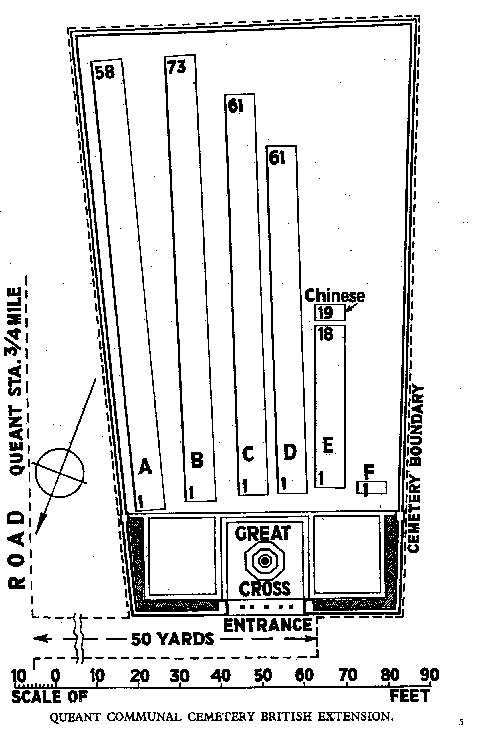
Canal-du-Nord and Cambrai: Fall 1918
During the fall of 1918 the focus of Allied objectives was to break through that most formidable of German defensive systems, the Hindenburg Line. The risk of encountering the entire German reserve massed against an Allied onslaught was too great. Instead of trying to focus the Allied effort by attacking the enemy at his strongest point, a new strategy was employed—to utilise the entire front from the Meuse to the English Channel and attack at different points. Canadian forces were to advance toward Cambrai.
Battleground: Canal-du-Nord and Cambrai
Cambrai is situated in the Nord-Pas de Calais region in northern France. It is surrounded by an elaborate system of canals providing links to the Steele and Scheldt rivers to the northeast and drainage of marshy lands. West of Cambrai lies the Canal-du-Nord, whose construction at the outbreak of war had been left incomplete, a serious obstacle to Allied troops advancing from the west. The enemy had flooded the already swampy area and there was only a 4,000-metre southward stretch in which the ground was firm and the Canal-du-Nord (itself 35 metres wide) was dry. If this passage could be crossed, Bourlon Wood and the high ground to the north could be captured. The enemy placed machine-gun posts close to the canal's flanks and other units were locked into natural defences. The main German defences at the Marquion Line were only a mile past the canal. The problem was to quickly move the whole Corps, with heavy artillery, through that narrow defile before the enemy attacked.
The Plan: A Two-Division, Three-Brigade Attack
The Canadian Corps, under General Sir Arthur Currie, was put in charge of operations conceived as a set-piece attack. Because of the extremely narrow divide, at zero hour on September 27, the battlefront presented only two brigades on the left and one on the right, with a creeping artillery barrage and sappers following over hastily-built bridges, pontoons and cork slabs baled with wire netting. One artillery subsection supported each divisional artillery section behind the front line.
Once across the canal, troops would reassemble and the front had to be widened at lightning speed from 2,600 metres to 15,000 metres in order to circle Bourlon Wood, capture the Blue Line and prepare to press forward toward Cambrai. In 12 hours of fighting, the Canadians covered approximately 8,500 metres of ground with the 4th Division's 38th, 87th and 102nd Battalions arriving first and the 1st Division's 1st and 13th Battalions following with greater difficulty. In the following four days of difficult fighting, both divisions, along with reinforcements from the 3rd Division, managed to secure only a limited amount of territory and by October 1, exhausted troops were ordered to rest and reassemble. Operations to capture Cambrai and secure ground northeast of the city resumed on October 8, mainly involving in the 2nd and 3rd Divisions and lasting a total of four days.
Map showing position of Canadian Corps units during the Battle of Canal Du Nord and Cambrai, 27 Sep - 11 Oct 1918. Annotation on map shows where Norman Robison of the "Fighting 10th" Battalion was killed in action on 29 Sep 1918.
Map courtesy Directorate of History and Heritage, National Defence Headquarters, Ottawa.
The Keys: Artillery, Engineers, Tanks and Communications
If the infantry undertook this delicate mission, it absolutely needed finely-tuned support from other divisional and corps troops. First, groups of artillery field brigades would relay each other in a continuous rolling barrage to support the infantry as it progressed through the Red, Green and Blue Lines, and as it fought a stiff battle onto Cambrai. Second, the engineer brigades were rapidly deployed, often working under machine gun fire to make the canals passable by building vital bridges and pontoons for artillery troops and floating foot bridges over water-tilled portions of the canal. Third, British 7th Battalion tanks were deployed en masse (four tanks per attacking infantry brigade) to fire, crush wires and create smoke screens from their exhaust pipes. Many war diarists note the invaluable service the tanks provided. Finally, without accurate communications to coordinate infantry and artillery advances, the operation's success could at best be limited. For example, if an infantry battalion advanced beyond its objective, but if the support artillery behind it remained without accurate information on its position, the results could be disastrous.
Battle Objectives: Red, Green and Blue Lines; Fighting towards Cambrai; Capture of Cambrai
British and Canadian military leaders puzzled long and hard over which course to take through the almost impassable marshland and a system of canals over which the enemy had an almost uninterrupted view from the higher ground beyond. The objective was for the 1st and 4th Divisions to quickly cross the Canal-du-Nord, take Bourlon Wood, and capture surrounding towns, pushing to the northeast. Then the 3rd Division would join them and push to the Cambrai/Douai Road opposite Tilloy. The 3rd and 4th Divisions would seize bridgeheads over the Canal de l'Escaut at Ramillies and Eswars, northeast of Cambrai, after which the 1st Division was to pass through their ranks to capture Abancourt east of the Douai Railway pushing on to Fressies at the Sensée Canal. The 2nd Division would then take its turn for the heart of the operation to capture Cambrai by forcing a passage over the Canal de l'Escaut between Morenchies and Ramillies and establishing a line on high ground behind Escaudoeuvres, "joining hands" with the British positioned there. Combined troops would then cross the canal and establish bridgeheads at Cambrai, clear the city and open the front eastward. Finally, ground northeast of Cambrai on both sides of the Canal de l'Escaut had to be cleared up to Iwuy.
Preparations
For the Canal-du-Nord and Cambrai offensives, the strength of the Canadian Corps, including attached troops, stood at 118,194 men. Of the 98,790 Canadians in this Corps, direct assault troops accounted for less than half of combatants. This meant that a great portion of the Corps was involved in preparations. Engineers, signal troops, transport and labour companies, and medical and veterinary units were all heavily involved in building bridges, relaying vital intelligence, constructing and repairing railway and communication lines, delivering supplies, caring for the wounded and maintaining horses. Under heavy attack not only from shells, but also machine-gun fire, they unfailingly carried out their work.
The Attack
5:20 a.m. (zero hour) on September 27. An artillery barrage exploded over enemy positions and
the 1st Division began to move swiftly. Successfully crossing the dry bed of the Canal-du-Nord as dawn broke, the Canadians rapidly secured the Green Line. Passing through their ranks, the 4th Division gained entry into the southern part of Bourlon Village around 9:45 a.m., but not without heavy casualties. By 2:00 p.m., they passed the Blue Line and attained the objective of capturing Bourlon Wood (Blue Line). Pushing on, by the end of the afternoon, while the 15th Infantry Brigade stood firm at the Blue Line, brigades from the 1st and 4th Canadian Division, plus the British 11th Division, cleared the enemy's Marcoing trench system. Victory was assured by 8:00 p.m. as the last pocket of enemy resistance is overcome.
Success: lst Division (Major-General MacDonell) and 4th Division (Major-General Watson), September 27, 1918
Setback: 1st Division, 3rd Division (Major-General Loomis ) and 4th Division, September 28-October 1. The first day's resounding success is mitigated by the setbacks of the ensuing four days. Having brilliantly met the first objective of the battle, the 1st and 4th Divisions prepared to press eastward to Cambrai along with the 3rd Division. They ran into unmapped wire and suffered heavy losses in front of the Douai Road, making progress only slowly and painfully to their intermediate objective of seizing bridges over the Canal de l'Escaut and establishing a united front across to the Canal de la Sensée. Before attempting to draw in on Cambrai, exhausted troops were forced to pause and reorganize.
Success: 2nd Division (Major-General Burstall) and 3rd Division, October 8-9. Attacking alone at 1:30 a.m. on October 8, after failing to make contact with British troops, the Canadian 2nd Division crossed a hastily-constructed bridge over the Canal de l'Escaut, successfully attaining the objective of forcing that passage. The 3rd Division established a line of posts on the eastern outskirts of Cambrai, and finally, the British moved up and joined with the 2nd Division northeast of Cambrai, as planned.
Setbacks for the 2nd Division in ending of the battle. In spite of its ultimate success, several incidents plagued the 2nd Division as it continued its advance beyond Cambrai. As it began to clear northeast of the city, it comes under heavy enemy fire and has to dig in. The Canadian Light Horse, also pushing ahead to secure the surrounding areas, falls into machine-gun fire at Iwuy and Naves. This causes heavy casualties to men and horses. Nevertheless, with Cambrai successfully captured and secured, at 5:00 p.m. on October 11, General Currie handed over the commands to the British 22nd Corps. The battle was over. Of the 68,500 men engaged in the conflict, 13,672 or 20 percent were lost in the Canal-du-Nord and Cambrai operations.
Source:
Veterans Affairs Canada
In memory of
Private
ARTHUR MCGEE
April 30, 1890 - February 11, 1919
Military Service:
Service Number: 444895
Age: 28
Force: Army
Unit: Canadian Infantry, Canadian Expeditionary Force, Canadian Expeditionary Force (CEF)
Division: 55th Battallion, later 43rd Battallion.
Commemorated on Page 538 of the First World War Book of Remembrance.
Military Service Records:
When a recruit signed up for the Canadian Expeditionary Force in WW I he filled in an attestation paper that indicated his willingness to serve in the military and provided such information as date of birth, next of kin, height, weight, complexion, occupation, etc. As such these papers are of genealogical importance. The links below are to a scanned copy of the attestion papers of Private Arthur McGee completed on 31 May, 1915, in Sussex, New Brunswick when he was inducted into the 55th Battalion of the Canadian Expeditionary Force.
Date of Enlistment:
May 31, 1915, Sussex, New Brunswick, Canada
Additional Information:
Private Arthur McGee was the son of Alexander McGee of Fredericton and Adelaide Rebecca Duplisea (living in Harvey at the time of her sons death), New Brunswick. Pte McGee stated on enlistment that he was single and worked as a laborer and was 25 years of age. He died of pneumonia on February 11, 1919 at Camp Bramshott, England, while waiting to be shipped home at the conclusion of WWI.
Cemetery:
Bramshott (St. Mary) Churchyard, North East Hampshire, England.
For more information on CEF burials at Bramshott see:
http://www.johnowensmith.co.uk/churches/bramshoi.htm
Grave Reference:
III. D. 21.

Newspaper Obituary:
"From undated 1919 newspaper clipping:
Died in England
Mrs. A. McGee, of Harvey Station, whose son, Pte. Arthur P. McGee, aged 29 years, died in England in February from phenomia, has received letters of sympathy from Chaplain Geo. C. Taylor, of the 43rd Battalion, who was with him at the time of his death, and Lieut. F. Appleyard, who spoke in the highest terms of the dead soldier. Pte. McGee was buried in the churchyard at Bramshott, and a tombstone has been erected by his comrades. He has 29 years of age and enlisted with the 55th Battalion, being transferred to the 43rd Battalion before going to France. Besides his widowed mother, three brothers, and five sisters survive - Hartley, who has just returned from overseas; Robert and William, of Harvey; Mrs. Geo Griffin, Montreal; Mrs. Fred Ketch, of this city; Miss Ages, of St. Barnabas Hospital, Woodford, Me., and Misses Edna and Fiola, at home.
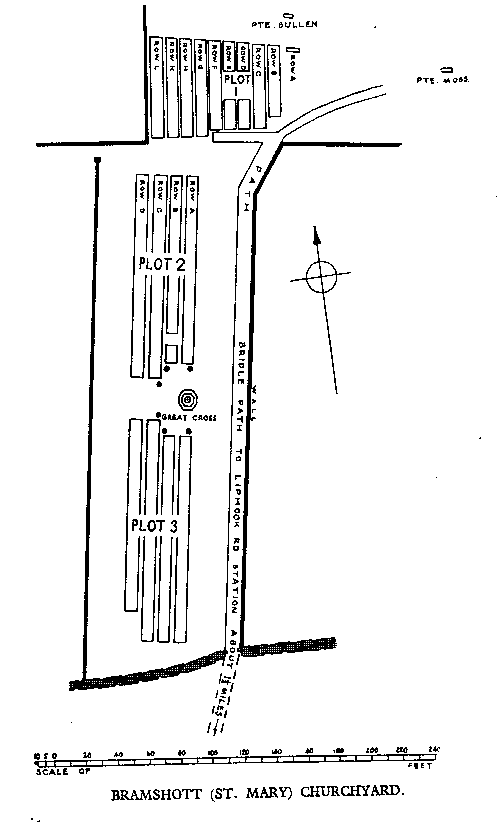

In memory of
Lieutenant (Nursing Sister)
MARGARET AGNES BRIGGS, RCAMC
Jan 1910 - February 22, 1945
Military Service:
Age: 35
Force: Army
Unit: Royal Canadian Army Medical Corps
Citation: Defence Medal, Canadian Volunteer Medal, War Medal 1939-1945, the 1939-1945 Star and the Italy Star.
Commemorated on Page 498 of the Second World War Book of Remembrance.
Additional Information:
Lt. Margaret Agnes Briggs was the daughter of Matheson J. Briggs
and Cora L. Little, of Harvey Station.
Cemetery:
Harvey Settlement Cemetery, Harvey Station, York County,
New Brunswick,Canada
Grave Reference:
1Leighton and Briggs Family Plot. Section B, Plot 881.
Stone reads:
Charles E. Leighton 1901 - 1941
husband of Vercelia G. Briggs 1902-1993
Their son Bryan R. Leighton 1940-1960
Nursing Sister (R.C.A.M.C) Margaret A. Briggs 1910-1945
Footstones read:
Margaret, Bryan, Charles
(Vercelia Gelena, nee Briggs, d/o J. Matheson Briggs and Cora Haslett; Bryan R. Leighton s/o Charles E. Leighton and Vercelia Briggs; Margaret A. Briggs 1910 - 1945, d/o J. Matheson Briggs and Cora Little. Vercelia Leighton was cremated).
1. Swan Hall, J.,Craig, H.C., Wood, G., Wood, M. 1999. Harvey Settlement Cemetery 1837-1999, ISBN 0-9687457-0-9, 141 p.
Link to Newspaper obituaries and articles
Link to account of Convoy KME-25A (Liverpool to Naples) and the torpedoeing and sinking of the SS Santa Elena off Phiippeville, Algeria Nov. 6, 1943.
1945 Newspaper Obituary (probably Daily Gleaner, Fredericton).
MacMinn, B. 2006 Name of Margaret Briggs Added to Harvey Cenotaph. The Fredericton Daily Gleaner, Monday, September 11, 2006
When a recruit signed up for the Canadian Expeditionary Force in WW I he filled in an attestation paper that indicated his willingness to serve in the military and provided such information as date of birth, next of kin, height, weight, complexion, occupation, etc. As such these papers are of genealogical importance. The links below are to a scanned copy of the attestion papers of Archie Little completed on 16 April 1918, in St. John, New Brunswick when he was drafted into the 1st Depot Battallion of the Canadian Expeditionary Force under the Military Service Act of 1917.

In memory of
Lieutenant (Nursing Sister)
MARGARET AGNES BRIGGS, RCAMC
Jan 1910 - February 22, 1945
Convoy KME-25A (Liverpool to Naples) November, 1943
During the first week of Nov 1943, Convoy KME-25A was assembled in Great Britain to transport war supplies and thousands of troop reinforcements for the army of General Mark Clark in Naples, Italy. With the clearance of debris and booby traps Naples was becoming a major base for the allied ground forces fighting in Italy.
Convoy KME-25A consisted of 8 British and 15 American transports escorted by 7 American, 3 British and 2Greek destroyers, as well as the anti-aircraft vessel HMS Colombo. Of most interest to Canadians was the transport S.S. Santa Elena, a luxury liner with the Grace Line before the war, which was carrying 1800 Canadians, including 121 Canadian Nursing Sisters of No. 14 Canadian General Hospital.
Prior to departure the nurses, including LT. (NS) Margaret A. Briggs were given 48 hours to pack and were not told their destination even after the convoy was at sea. The voyage from Liverpool to the Mediterranean was routine and uneventful. Due to U-boat activity the convoy followed the standard zig-zag pattern. There was little to fear from air attack though as there was allied air cover. The convoy steamed along the Algerian coast but was too large to pass through the Tunisian War Channel in the standard formation of columns of three ships each. Instead the convoy was strung out in less maneuverable and more vulnerable, seven and nine ship columns. The Allied air screen also disappeared at this time.

SS Santa Elena was carrying 1800 Canadian soldiers and 121 nursing sisters when it was torpedoed off Philippeville, North Africa on 6 Nov. 1943.
By Nov 6 the ships had left Algiers behind and were approaching Philippeville at 12 knots. At exactly 1800 not far from Cape Bougaroun a Luftwaffe mixed force of nine bombers and 16 torpedo planes came in low dropping torpedoes and deploying radio controlled glider bombs.
The destroyer USS Beatty (DD-640) was hit by a torpedo on the starboard side at the after engine room. The ship came to halt and sagged in the water with a broken keel. The damaged hull could not stand the strain of the flooding and the ship broke in two and sank with the loss of twelve sailors. Two transports were also torpedoed; the S.S.Aldegonde and the S.S.Santa Elena.
Aboard the S.S. Santa Elena there was a deafening explosion that shook the ship. The engines stopped and power was lost. The ship began to drift and started to take on water. The ship took a second hit when a bomb crashed into the deck near the stern.
The order came to abandon ship and the nurses put on life jackets and got into the lifeboats. Some soldiers panicked and jumped into the water. Many of them subsequently clung to the sides of the lifeboats.

The escort destroyer USS Tillman (DD-641) picked up 36 of the female hospital staff after they had abandoned the SS Santa Elena.
The nurses took to the oars in some life boats and helped row around in circles until they were rescued two or three hours later. Two boatloads, including thirty-six of the hospital's female staff, were taken aboard the American destroyer USS Tillman (DD-641).
The nursing sisters in the other boats were faced with a scary fifty-foot climb up the towering side of the S.S. Monterey, another former luxury liner turned troopship that was standing by to pick up survivors. The nurses' "hardening" training in England had not included practice with scramble nets that hung down the liner's side, swaying outward with each roll of the ship. But with dogged perserverance all made the difficult ascent to the deck of the Monterey, many using their elbows rather than their hands to haul themselves up. Lt. Margaret Briggs fell into the sea from forty feet up, but was rescued by a Chinese cook who dove in from a lifeboat. There was no loss of life in the abandonment.

LT. (N/S) Margaret A. Briggs, RCAMC. Source: Paul Briggs, via Brenda MacMinn, 2006.
The crew and Armed Guard returned to the Santa Elena on Nov 7. However, the ship suffered further damage when accidentally rammed by another damaged ship, the Dutch transport Marnix Van St. Aldegonde (then under tow). The Monterey attempted to tow the Santa Elena but the ship could not stand the strain and sank off Phillipville Harbour, North Africa. The nurses and soldiers lost all of their possessions and equipment. Four of the 133-man merchant crew unfortunately perished in the final abandonment of the Santa Elena.
Rough weather prevented the Monterey from docking at Phillipville, and she was ordered to proceed to Naples. The same heavy seas also prevented attempts to transfer the nurses that were on the Tillman to the Monterey.
They were put ashore at Philippeville, and spent a week as guests of No. 15 General Hospital at El Arrouch before taking ship to Naples.
In the action report report following the incident the configuration of Convoy KME-25A was severely criticized. Convoy speed was unnecessarily slow. It was concluded tat troop ship convoys should steam at the maximum speed of the slowest ship and rendezvous should be arranged accordingly. Having fast ships carrying 4000 to 7000 troops steam at speeds of a slow12 knots was deemed foolhardy. A number of large ships in the convoy were capable of eighteen knots or better and the Monterey carrying 7000 troops was capable of 20 knots. It was thus concluded that convoys should be split into two groups upon entering the Mediterranean into a fast and slow group.

SS Monterey was carry 7000 US soldiers as part of convoy KME-25A but took on an additional 1800 Canadian soldiers and most of the nursing sisters of No 14 Canadian General Hospital after the SS Santa Elena was struck by a torpedo.
In memory of
Lieutenant (Nursing Sister)
MARGARET AGNES BRIGGS, RCAMC
Jan 1910 - February 22, 1945
Newspaper obituaries and articles
21945 Newspaper Obituary (probably Daily Gleaner, Fredericton):
A large circle of friends and relatives will learn with sincere regret of the death of Lieut. (Nursing Sister) Margaret A. Briggs.
Lieut. Briggs, born at York Mills, N.B., 35 years ago, was a daughter of Mrs. Cora Briggs and the Late James Matheson Briggs. When war was declared Lieut. Briggs was a member of the staff of Child's Welfare, Montreal, and enlisted as a nursing sister. She spent three years overseas, in hospitals in England and later in Italy. Enroute to Italy with a medical unit the hospital ship St. Helena was torpedoed in the Mediterranean. After six months' service in the Italian war zone, Lieut. Briggs developed a serious illness and was invalided home as a bed patient. She entered the Royal Victoria Hospital and passed away there on Thursday morning. Her deep devotion to her profession and kindness to all in her care will long be remembered.
2. Watson, J. S., Saunders Swan, B., and Swan Hall, J. 1992. The Little Family of Harvey Station, 1792-1982, (self published family genealogy) p. 226
Reprint of newspaper article documenting addition of LT. (N/S) Margaret A. Briggs to the Harvey Cenotaph. Reprinted with permission of author Brenda MacMinn.
NAME OF MARGARET BRIGGS OF YORK MILLS
ADDED TO HARVEY CENOTAPH
LT. (N/S) Margaret Agnes Briggs, RCAMC.
Source: Paul Briggs, via Brenda MacMinn, 2006.
The Daily Gleaner, Monday, September 11, 2006
BY BRENDA MACMINN
After more than 60 years, the name of Lt. (NS - Nursing Sister) Margaret Agnes Briggs has taken its rightful place on the cenotaph in Harvey Station.
Margaret Briggs was born, resided and was educated in York Mills, near Harvey. She attended Normal School in Fredericton where she obtained her teaching license. Her life took a different turn when she pursued her nursing degree following her training at the Royal Victoria Hospital in Montreal.
Following her work with the Child Welfare Organization as a nurse for the City of Montreal, Briggs joined the Royal Canadian Army Medical Corps as a nurse and was posted to #14 Canadian General Hospital, traveling overseas to Scotland on the ship "Stirling Castle." On her arrival there she treated wounded soldiers and airmen returning to Scotland for medical care.
In October, 1943, she sailed from Liverpool, England, bound for a posting in Italy. On November 6, 1943, the ship on which she was traveling, the SS Santa Elena, sank following being torpedoed by a German aircraft, leaving Briggs in the waters of the Mediterranean.
Historical facts are not clear as to whether she was picked up by the SS Monterey or USS Tillman but while climbing the scramble nets flung over the side of the rescuing ship, she fell sustaining injuries that led to her death on February 22, 1945, after being returned to England and subsequently to Montreal. She was 35 years old. Briggs is buried in the Harvey Settlement Cemetery.
More than 50 veterans, family and friends gatheredat the cenotaph in Harvey on Saturday afternoon for the unveiling of her name by her nephew, Paul Briggs of Fredericton.
Paul Briggs remembers when his aunt's remains were brought back to her home village for burial. He said he was about five years old at the time. Her cousin, Lottie Messer, now 98, was a couple of years older than Briggs but remembers her kind nature and spending time at their grandparents in Harvey.
Messer attended the cenotaph service on Saturday.

A Moment: Paul Briggs, left, unveiled the plaque commemorating the loss of life and service to her country of Lieut. Nursing Sister Margaret A. Briggs. Red Hayes is kneeling to the right. Source: Brenda MacMinn, 2006.

Addition of LT. (N/S) Margaret Agnes Briggs, RCAMC to Harvey Cenotaph in September 2006. Source: Brenda MacMinn, 2006.
"She often came to the Woolen Mill office where I was working and we would chat about what was going on in our lives" said Messer who was about 17 at the time while Briggs was about 15.
Regina Clark, now residing in Fredericton, was brought up across the road from Briggs home in York Mills. Their fathers were partners in the Briggs and Little Woolen Mill of the day. Clark remembers visiting her in her home when she was growing up.
"Their home had the most wonderful smell" remembers Clark, "and she would invite us to go upstairs to herroom where she would show us her dolls."
"She was a little older than I was and we younger ones looked up to her," said Clark.
Through his research in finding the history of all the New Brunswick casualties of Second World War, Red Hayes of Harvey, retired from the Canadian Armed Forces, discovered that Lt. (NS) Margaret A. Briggs name was missing from the lists that he had.
Hayes related that because she had joined the army in Quebec, she was not listed as a New Brunswicker, which was what he was researching. Each year, Hayes and comrade, Royden Messer, also retired from the Canadian Armed Forces, placed Canadian flags on the white crosses placed on all the veteransí graves in the cemeteries in the Harvey area. "The one thing I didn't realize was that she was not just a veteran of the Second World War but was also a casualty of the war. At one point it clicked that she was not on the cenotaph in our village," said Hayes.
Through his efforts, Briggs name has now taken its rightful place on the memorial. "It gives me great pleasure to honor this lady here today who paid the supreme sacrifice of her life for her country and to her fellow service people" said Hayes.
Although Veterans Affairs Minister Greg Thompson could not be present, Margie Gregg from Thompson's office, was proud that this recognitioncould be made.

Program for plaque dedication ceremony for Lieut. Margaret Agness Briggs, RCAMC. Source: Brenda MacMinn, 2006.
The unveiling of this plaque honors the great sacrifice of our veterans and preserves the historical legacy for generations to come, she said.
"Today after so many years Nursing Sister Briggs is being both honored and taking her rightful place in our province's proud history" said Gregg. "By adding her name to this cenotaph we are fully recognizing her to Canada and her ultimate sacrifice for the way of life we now enjoy. It is a debt we owe to her and one we will never forget."
On behalf of Minister Thompson, Gregg thanked those responsible for this very fitting tribute to one of New Brunswick's many brave women and men in uniform and congratulate you for keeping the torch of remembrance burning so strongly and so brightly."
Roger Shaw of the Fredericton and Area Highland Pipes and Drums played a bagpipe lament entitled Flowers of the Forest.
Veterans and Cadets attending the ceremony placed poppies on the wreath laid by Winston Gamblin, mayor of Harvey.
Briggs had been awarded the following medals for her service to her country: Defense Medal, Canadian Volunteer Medal, The War Medal 1939-1945, The 1939-1945 Star and the Italy Star.






















